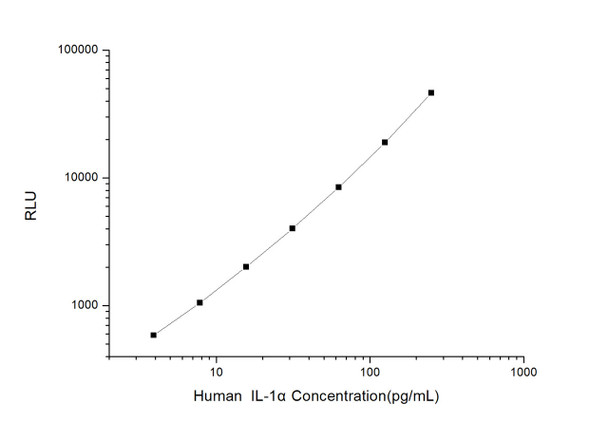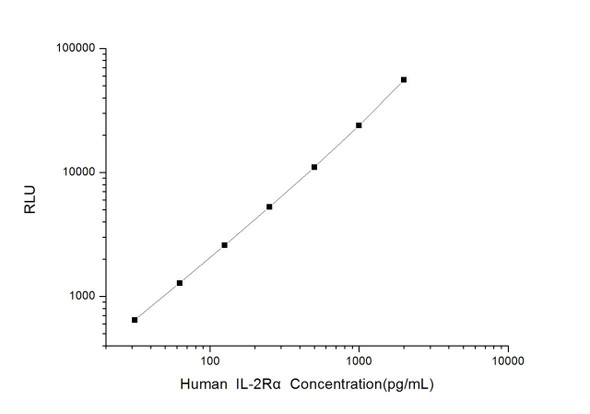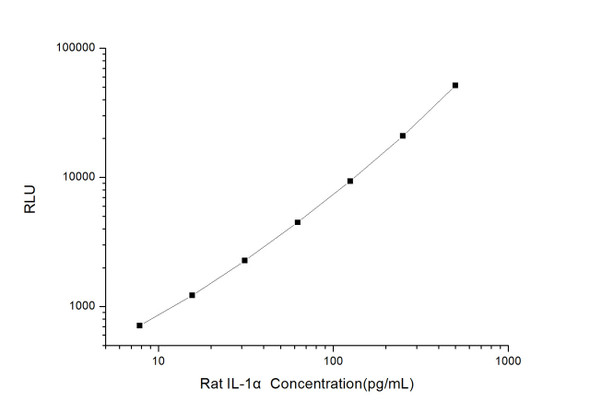Human Immunology ELISA Kits 1
Human IL-1 alpha CLIA Kit (HUES00085)
- SKU:
- HUES00085
- Product Type:
- ELISA Kit
- ELISA Type:
- CLIA Kit
- Size:
- 96 Assays
- Sensitivity:
- 2.34pg/mL
- Range:
- 3.91-250pg/mL
- ELISA Type:
- Sandwich
- Synonyms:
- IL1A, IL1-A, IL1, IL1F1, Preinterleukin 1 Alpha, Hematopoietin-1, Pro-Interleukin-1-Alpha
- Reactivity:
- Human
- Sample Type:
- Serum, plasma and other biological fluids
- Research Area:
- Immunology
Description
| Assay type: | Sandwich |
| Format: | 96T |
| Assay time: | 4.5h |
| Reactivity: | Human |
| Detection method: | Chemiluminescence |
| Detection range: | 3.91-250 pg/mL |
| Sensitivity: | 2.34 pg/mL |
| Sample volume: | 100µL |
| Sample type: | Serum, plasma and other biological fluids |
| Repeatability: | CV < 15% |
| Specificity: | This kit recognizes Human IL1 alpha CLIA Kit in samples. No significant cross-reactivity or interference between Human IL1 alpha CLIA Kit and analogues was observed. |
This kit uses Sandwich-CLIA as the method. The micro CLIA plate provided in this kit has been pre-coated with an antibody specific to Human IL1 alpha. Standards or samples are added to the appropriate micro CLIA plate wells and combined with the specific antibody. Then a biotinylated detection antibody specific for Human IL1 alpha and Avidin-Horseradish Peroxidase (HRP) conjugate are added to each micro plate well successively and incubated. Free components are washed away. The substrate solution is added to each well. Only those wells that contain Human IL1 alpha, biotinylated detection antibody and Avidin-HRP conjugate will appear fluorescence. The Relative light unit (RLU) value is measured spectrophotometrically by the Chemiluminescence immunoassay analyzer. The RLU value is positively associated with the concentration of Human IL1 alpha. The concentration of Human IL1 alpha in the samples can be calculated by comparing the RLU of the samples to the standard curve.
| UniProt Protein Function: | IL1A: Produced by activated macrophages, IL-1 stimulates thymocyte proliferation by inducing IL-2 release, B-cell maturation and proliferation, and fibroblast growth factor activity. IL-1 proteins are involved in the inflammatory response, being identified as endogenous pyrogens, and are reported to stimulate the release of prostaglandin and collagenase from synovial cells. Belongs to the IL-1 family. |
| UniProt Protein Details: | Protein type:Motility/polarity/chemotaxis; Cytokine Chromosomal Location of Human Ortholog: 2q14 Cellular Component: extracellular space; extracellular region; cytosol Molecular Function:protein binding; copper ion binding; interleukin-1 receptor binding; cytokine activity Biological Process: positive regulation of I-kappaB kinase/NF-kappaB cascade; positive regulation of mitosis; apoptosis; positive regulation of interleukin-2 biosynthetic process; cytokine and chemokine mediated signaling pathway; germ cell programmed cell death; positive regulation of JNK cascade; fever; negative regulation of cell proliferation; cell proliferation; connective tissue replacement during inflammatory response; positive regulation of angiogenesis; response to copper ion; positive regulation of transcription from RNA polymerase II promoter; immune response; inflammatory response; positive regulation of cytokine secretion |
| NCBI Summary: | The protein encoded by this gene is a member of the interleukin 1 cytokine family. This cytokine is a pleiotropic cytokine involved in various immune responses, inflammatory processes, and hematopoiesis. This cytokine is produced by monocytes and macrophages as a proprotein, which is proteolytically processed and released in response to cell injury, and thus induces apoptosis. This gene and eight other interleukin 1 family genes form a cytokine gene cluster on chromosome 2. It has been suggested that the polymorphism of these genes is associated with rheumatoid arthritis and Alzheimer's disease. [provided by RefSeq, Jul 2008] |
| UniProt Code: | P01583 |
| NCBI GenInfo Identifier: | 124297 |
| NCBI Gene ID: | 3552 |
| NCBI Accession: | P01583. 1 |
| UniProt Secondary Accession: | P01583,Q53QF9, Q7RU02, |
| UniProt Related Accession: | P01583 |
| Molecular Weight: | 30,607 Da |
| NCBI Full Name: | Interleukin-1 alpha |
| NCBI Synonym Full Names: | interleukin 1, alpha |
| NCBI Official Symbol: | IL1A |
| NCBI Official Synonym Symbols: | IL1; IL-1A; IL1F1; IL1-ALPHA |
| NCBI Protein Information: | interleukin-1 alpha; IL-1 alpha; hematopoietin-1; preinterleukin 1 alpha; pro-interleukin-1-alpha |
| UniProt Protein Name: | Interleukin-1 alpha |
| UniProt Synonym Protein Names: | Hematopoietin-1 |
| Protein Family: | Interleukin |
| UniProt Gene Name: | IL1A |
| UniProt Entry Name: | IL1A_HUMAN |
As the RLU values of the standard curve may vary according to the conditions of the actual assay performance (e. g. operator, pipetting technique, washing technique or temperature effects), the operator should establish a standard curve for each test. Typical standard curve and data is provided below for reference only.
| Concentration (pg/mL) | RLU | Average | Corrected |
| 250 | 42054 50450 | 46252 | 46216 |
| 125 | 17174 20690 | 18932 | 18896 |
| 62.5 | 9102 7858 | 8480 | 8444 |
| 31.25 | 3840 4270 | 4055 | 4019 |
| 15.63 | 2122 1966 | 2044 | 2008 |
| 7.81 | 1130 1046 | 1088 | 1052 |
| 3.91 | 582 664 | 623 | 587 |
| 0 | 35 37 | 36 | -- |
Precision
Intra-assay Precision (Precision within an assay): 3 samples with low, mid range and high level Human IL1 alpha CLIA Kit were tested 20 times on one plate, respectively.
Inter-assay Precision (Precision between assays): 3 samples with low, mid range and high level Human IL1 alpha CLIA Kit were tested on 3 different plates, 20 replicates in each plate.
| Intra-assay Precision | Inter-assay Precision | |||||
| Sample | 1 | 2 | 3 | 1 | 2 | 3 |
| n | 20 | 20 | 20 | 20 | 20 | 20 |
| Mean (pg/mL) | 13.26 | 20.84 | 98.37 | 12.95 | 21.47 | 101.31 |
| Standard deviation | 1.65 | 2.33 | 7.22 | 1.20 | 2.06 | 9.84 |
| C V (%) | 12.44 | 11.18 | 7.34 | 9.27 | 9.59 | 9.71 |
Recovery
The recovery of Human IL1 alpha CLIA Kit spiked at three different levels in samples throughout the range of the assay was evaluated in various matrices.
| Sample Type | Range (%) | Average Recovery (%) |
| Serum (n=5) | 88-100 | 93 |
| EDTA plasma (n=5) | 94-109 | 100 |
| Cell culture media (n=5) | 90-106 | 97 |
Linearity
Samples were spiked with high concentrations of Human IL1 alpha CLIA Kit and diluted with Reference Standard & Sample Diluent to produce samples with values within the range of the assay.
| Serum (n=5) | EDTA plasma (n=5) | Cell culture media (n=5) | ||
| 1:2 | Range (%) | 92-107 | 99-110 | 98-113 |
| Average (%) | 98 | 104 | 104 | |
| 1:4 | Range (%) | 94-107 | 98-115 | 93-106 |
| Average (%) | 100 | 105 | 99 | |
| 1:8 | Range (%) | 100-113 | 88-102 | 96-107 |
| Average (%) | 108 | 94 | 102 | |
| 1:16 | Range (%) | 92-103 | 98-109 | 87-102 |
| Average (%) | 98 | 104 | 94 |
An unopened kit can be stored at 4°C for 1 month. If the kit is not used within 1 month, store the items separately according to the following conditions once the kit is received.
| Item | Specifications | Storage |
| Micro CLIA Plate(Dismountable) | 8 wells ×12 strips | -20°C, 6 months |
| Reference Standard | 2 vials | |
| Concentrated Biotinylated Detection Ab (100×) | 1 vial, 120 µL | |
| Concentrated HRP Conjugate (100×) | 1 vial, 120 µL | -20°C(shading light), 6 months |
| Reference Standard & Sample Diluent | 1 vial, 20 mL | 4°C, 6 months |
| Biotinylated Detection Ab Diluent | 1 vial, 14 mL | |
| HRP Conjugate Diluent | 1 vial, 14 mL | |
| Concentrated Wash Buffer (25×) | 1 vial, 30 mL | |
| Substrate Reagent A | 1 vial, 5 mL | 4°C (shading light) |
| Substrate Reagent B | 1 vial, 5 mL | 4°C (shading light) |
| Plate Sealer | 5 pieces | |
| Product Description | 1 copy | |
| Certificate of Analysis | 1 copy |
- Set standard, test sample and control (zero) wells on the pre-coated plate and record theirpositions. It is recommended to measure each standard and sample in duplicate. Note: addall solutions to the bottom of the plate wells while avoiding contact with the well walls. Ensuresolutions do not foam when adding to the wells.
- Aliquot 100µl of standard solutions into the standard wells.
- Add 100µl of Sample / Standard dilution buffer into the control (zero) well.
- Add 100µl of properly diluted sample (serum, plasma, tissue homogenates and otherbiological fluids. ) into test sample wells.
- Cover the plate with the sealer provided in the kit and incubate for 90 min at 37°C.
- Aspirate the liquid from each well, do not wash. Immediately add 100µL of BiotinylatedDetection Ab working solution to each well. Cover the plate with a plate seal and gently mix. Incubate for 1 hour at 37°C.
- Aspirate or decant the solution from the plate and add 350µL of wash buffer to each welland incubate for 1-2 minutes at room temperature. Aspirate the solution from each well andclap the plate on absorbent filter paper to dry. Repeat this process 3 times. Note: a microplatewasher can be used in this step and other wash steps.
- Add 100µL of HRP Conjugate working solution to each well. Cover with a plate seal andincubate for 30 min at 37°C.
- Aspirate or decant the solution from each well. Repeat the wash process for five times asconducted in step 7.
- Add 100µL of Substrate mixture solution to each well. Cover with a new plate seal andincubate for no more than 5 min at 37°C. Protect the plate from light.
- Determine the RLU value of each well immediately.






